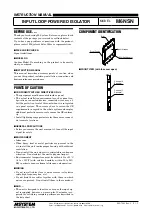
Operation
SMART 200 TSS
-3.3 -
6.
Operator’s Message Area.
The menu choices, or settings for the selected function during programming or
setup phase of the system as well as service messages are displayed with large size
fonts
(1.5 x 0.8 cm),
easy to read even from a distance, when the system is running
normally. In other words, it shows all the necessary information to guide the
operator step by step through the programming phase and interactive management
of the system.
When the displayed lines refer to the menu items, the selected one is indicated with
the symbol
>
.
The presence of a flashing cursor
(---)
indicates the position where the operator
can enter an alphanumeric character or variable setting which will replace the value
currently displayed.
When you select the GRAPH function from Main Menu, this area is used to
graphically represent the tension detected by a specific sensor, or to compare by
means of a histogram the readings of multiple sensors
(8, 12, 16)
.
7.
Operating Status Signalling Area
To enable a more direct and evident interpretation of the operating context in
which you are working, on the right hand side and bottom side of the operator
message area, 16 rectangular boxes
(labels)
are implemented. They display the
operating status of the system, and the hierarchic level of the menu at which you
are operating.
More specifically, the
PROGRAM
label indicates that you are operating in one of
the following modes: configuration, programming or data transmission to the
sensors.
The
CONTROL
label indicates that the system is operating normally with all
monitor functions enabled, and according to the parameters currently set in the
system. In this phase the message display indicates
CONTROL OK
.
The
ERROR
label indicates that an error has been detected during normal
operation of the system. In this case the Message area shows the type of error
detected
(for further information please refer to Operations Sequences in this
chapter and to chapter 4 – Troubleshooting and Maintenance).
The labels
P1 .. P5
indicate the hierarchic level of the menu in which you are
operating.
P1
is the highest level,
P5
is the lowest hierarchical level. To move
from an upper to a lower level you must normally press down the
ENTER
button,
while to do the opposite, i.e. going from a lower to an upper level you must press
the
RESET
button.
SMART
200 TSS
Содержание SMART 200 TSS
Страница 1: ...SMART 200 TSS TS5 YARN CONTROL SYSTEM Operating Manual Rev 2 0 July 2003 ENGLISH ...
Страница 8: ...Introduction I 4 SMART 200 TSS Page intentionally left blank ...
Страница 16: ...Technical data and installation 2 6 SMART 200 TSS Page intentionally left blank ...
Страница 22: ...Operation 3 6 SMART 200 TSS Technical Characteristics of TS5 sensor Sizes mm ...
Страница 32: ...Operation 3 16 SMART 200 TSS Enabling the SETUP Menu Functions CONFIG ...
Страница 34: ...Operation 3 18 SMART 200 TSS Enabling the GRAPH Menu Function ...
Страница 74: ...Operation 3 58 SMART 200 TSS Production Report Example ...
Страница 80: ...Troubleshooting and Maintenance 4 6 SMART 200 TSS Page intentionally left blank ...
Страница 82: ...Appendix A Quick Reference Symbols Key A 2 SMART 200 TSS ...
Страница 83: ...Appendix A Quick Reference Symbols Key SMART 200 TSS A 3 ...
Страница 84: ...Appendix A Quick Reference Symbols Key A 4 SMART 200 TSS ...
Страница 85: ...Appendix A Quick Reference Symbols Key SMART 200 TSS A 5 ...
Страница 86: ...Appendix A Quick Reference Symbols Key A 6 SMART 200 TSS ...
Страница 87: ...Appendix A Quick Reference Symbols Key SMART 200 TSS A 7 ...
Страница 88: ...Appendix A Quick Reference Symbols Key A 8 SMART 200 TSS ...
Страница 89: ...Appendix A Quick Reference Symbols Key SMART 200 TSS A 9 ...
Страница 90: ...Appendix A Quick Reference Symbols Key A 10 SMART 200 TSS ...
Страница 91: ...Appendix A Quick Reference SMART 200 TSS A 11 Note ...
Страница 92: ...Appendix A Quick Reference A 12 SMART 200 TSS Page intentionally left blank ...
















































